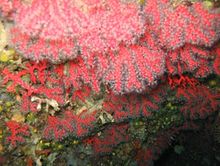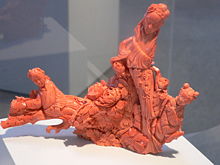Precious coral
| Precious coral | |
|---|---|

| |
| Scientific classification | |
| Domain: | Eukaryota |
| Kingdom: | Animalia |
| Phylum: | Cnidaria |
| Class: | Octocorallia |
| Order: | Alcyonacea |
| Family: | Coralliidae |
| Genus: | Corallium Cuvier, 1798 |
| Species | |
|
31 species, see text | |
Precious coral,orred coral,is the common name given to a genus of marinecorals,Corallium.The distinguishing characteristic of precious corals is their durable and intensely colored red or pink-orangeskeleton,which is used for makingjewelry.
Habitat
[edit]Red corals grow on rocky seabottom with lowsedimentation,typically in dark environments—either in the depths or in dark caverns or crevices. The original species,C. rubrum(formerlyGorgonia nobilis), is found mainly in the Mediterranean Sea. It grows at depths from 10 to 300 meters below sea level, although the shallower of these habitats have been largely depleted by harvesting.[1]In the underwater caves ofAlghero,Sardinia(the "Coral Riviera" ), it grows at depth from 4 to 35 meters. The same species is also found at Atlantic sites near theStrait of Gibraltar,at theCape VerdeIslands and off the coast of southern Portugal.[1]OtherCoralliumspecies are native to the western Pacific, notably around Japan and Taiwan;[2]these occur at depths of 350 to 1500 meters below sea level in areas with strong currents.[1]
Anatomy
[edit]In common with otherAlcyonacea,red corals have the shape of small leafless bushes and grow up to a meter in height. Their valuable skeleton is composed of intermeshed spicules of hardcalcium carbonate,colored in shades of red bycarotenoidpigments.[1]In living specimens, the skeletal branches are overlaid with soft bright redintegument,from which numerous retractable whitepolypsprotrude.[3]The polyps exhibitoctamericradial symmetry.
Species
[edit]The following are known species in the genus:[4]
- Corallium abyssaleBayer, 1956
- Corallium bathyrubrumSimpson & Watling, 2011
- Corallium bayeriSimpson & Watling, 2011
- Corallium borneanseBayer
- Corallium boshuenseKishinouye, 1903
- Corallium carusrubrumTu, Dai & Jeng, 2012
- Corallium ducaleBayer
- Corallium elatiusRidley, 1882
- Corallium gotoenseNonaka, Muzik & Iwasaki, 2012
- Corallium halmaheirenseHickson, 1907
- Corallium imperialeBayer
- Corallium johnsoniGray, 1860
- Corallium kishinouyeiBayer, 1996
- Corallium konojoiKishinouye, 1903
- Corallium laauenseBayer, 1956
- Corallium maderense(Johnson, 1899)
- Corallium medeaBayer, 1964
- Corallium niobeBayer, 1964
- Corallium niveumBayer, 1956
- Corallium occultumTzu-Hsuan Tu et al., 2015
- Corallium porcellanumPasternak, 1981
- Corallium pusillumKishinouye, 1903
- Corallium regaleBayer, 1956
- Corallium rubrum(Linnaeus, 1758)
- Corallium secundumDana, 1846
- Corallium sulcatumKishinouye, 1903
- Corallium taiwanicumTu, Dai & Jeng, 2012
- Corallium tricolor(Johnson, 1899)
- Corallium uchidaiNonaka, Muzik & Iwasaki, 2012
- Corallium vanderbiltiBoone, 1933
- Corallium variabile(Thomson & Henderson, 1906)
As a gemstone
[edit]

The hard skeleton of red coral branches is naturally matte, but can be polished to a glassy shine.[2]It exhibits a range of warm reddish pink colors from pale pink to deep red; the wordcoralis also used to name such colors. Owing to its intense and permanent coloration and glossiness, precious coral skeletons have been harvested since antiquity for decorative use. Coral jewellery has been found inancient Egyptianandprehistoric Europeanburials,[3]and continues to be made to the present day. It was especially popular during theVictorian age.[5]
Precious coral has hardness 3.5 on theMohs scale.[6]Due to its softness and opacity, coral is usually cuten cabochon,or used to makebeads.[7]
History of trade
[edit]


At the beginning of the 1st millennium, there was significant trade in coral between the Mediterranean and India, where it was highly prized as a substance believed to be endowed with mysterious sacred properties.Pliny the Elderremarks that, before the great demand from India, theGaulsused it for the ornamentation of their weapons and helmets; but by this period, so great was the Eastern demand, that it was very rarely seen even in the regions which produced it. Among theRomans,branches of coral were hung around children's necks to preserve them from danger from the outside, and the substance had many medicinal virtues attributed to it. The belief in coral's potency as acharmcontinued throughout the Middle Ages and early in 20th century Italy it was worn as a protection from theevil eye,and by women as a cure forinfertility.

From the Middle Ages onward, the securing of the right to the coral fisheries off the African coasts was the object of considerable rivalry among the Mediterranean communities of Europe.
The story of theTorre del Grecois so interwoven with that of the coral so as to constitute an inseparable pair, and is documented as early as the fifteenth century. In 1790 the Royal Society of Coral was established in the town of Torre del Greco, with the idea of working and selling coral fish. This shows that the coral fishing flourished for many years in the city.[citation needed]
It was also enacted December 22, 1789, by Ferdinand IV of Bourbon Code coral (prepared by the Neapolitan jurist Michael Florio), with the intent to regulate the coral fishing in those years starring, in addition to the sailors Torre del Greco, the locals and those in Trapani This regulation did not have the expected success. From 1805, when he founded the first factory for the manufacturing of coral in Torre del Greco (by Paul Bartholomew Martin, but with French Genoese origin), the golden age for the manufacturing of coral in the city situated on the slopes of the Vesuvius started, because working together with the coral fishing was increasingly under the control of Torre del Greco fishermen. Since 1875, the Torre del Greco began working with the Sciacca coral and a school for the manufacturing of coral was built in 1878 in the city (which closed in 1885 to reopen in 1887), with which in 1933 established a museum of the coral. Then came the time of processing of Japanese coral found in the markets of Chennai and Kolkata.[citation needed]
Other story instead a short period the Tunisian fisheries were secured byCharles Vfor Spain; but the monopoly soon fell into the hands of the French, who held the right until the Revolutionary government in 1793 threw the trade open. For a short period (about 1806) the British government controlled the fisheries, but this later returned to the hands of the French authorities. Before theFrench Revolutionmuch of the coral trade was centred inMarseille,but then largely moved to Italy, where the procuring of the raw material and the working of it was centring inNaples,RomeandGenoa.[8]
In culture
[edit]This sectionneeds additional citations forverification.(October 2012) |
The origin of coral is explained inGreek mythologyby the story ofPerseus.Having petrifiedCetus,the sea monster threateningAndromeda,Perseus placedMedusa's head on the riverbank while he washed his hands. When he recovered her head, he saw that her blood had turned theseaweed(in some variants the reeds) into red coral. Thus, the Greek word for coral is 'Gorgeia', as Medusa was one of the threeGorgons.[9]
Poseidonresided in a palace made of coral and gems, andHephaestusfirst crafted his work from coral.
TheRomansbelieved coral could protect children from harm, as well as cure wounds made by snakes and scorpions and diagnose diseases by changing colour.
- InHinduastrologyred coral is associated with the planetMarsor Graha-Mangalaand used for pleasing Mars. It should be worn on the ring finger.
- A branch of red coral figures prominently in the civiccoat of armsof the town ofAlghero,Italy.
- InIslamcoral is mentioned as one of the gems in paradise.
- Amongst theYorubaandBini peoplesof West Africa, red precious coral jewellery (necklaces, wristlets and anklets most especially) are signifiers of high social rank, and are worn as a result by titledkingsandchieftains.
- In traditional Dutch culture, notably in fishing communities, red coral necklaces were worn by the female population as an indispensable part of the traditional costumes.[10]
Conservation
[edit]Intensive fishing, particularly in shallow waters, has damaged this species along the Mediterranean coastline, where colonies at depths of less than 50 metres are much diminished. Fishing andclimate changethreaten their persistence. The three oldest Mediterraneanmarine protected areas—Banyuls, Carry-le-Rouet and Scandola, off the island of Corsica—all host substantial populations ofC. rubrum.Since protection was established, colonies have grown in size and number at shallow and deeper depths.[11][12]
See also
[edit]- Coral Jewellery Museum
- Black coral;also sometimes used as ornamental material
- Amber
- Pearl
References
[edit]- ^abcd"Corallium species".ARKive.Archived fromthe originalon June 20, 2007.RetrievedFebruary 15,2007.
- ^ab "Gemstones: Coral".Archived fromthe originalon February 9, 2007.RetrievedFebruary 15,2007.
- ^ab"Red Coral".Marenostrum.RetrievedFebruary 15,2007.
- ^"WoRMS - World Register of Marine Species - Corallium Cuvier, 1798".Marinespecies.org. December 21, 2004.RetrievedOctober 9,2013.
- ^Anderson, Katharine (2008). "Coral Jewellery".Victorian Review.34(1): 47–52.doi:10.1353/vcr.2008.0008.JSTOR41220397.S2CID201782824.
- ^"Jewelry Central".RetrievedFebruary 15,2007.
- ^Balzan, Francesca; Deidun, Alan (2010)."Notes for a history of coral fishing and coral artefacts in Malta - The Significance of Coral: Apotropaic, Medical, Symbolic, Precious".In Joseph F. Grima (ed.).60th anniversary of the Malta Historical Society: a commemoration.Zabbar: Veritas Press. pp. 435–454.ISBN978-99932-0-942-3.OCLC779340904.Archived fromthe originalon March 25, 2019.
- ^Chisholm, Hugh,ed. (1911)..Encyclopædia Britannica.Vol. 7 (11th ed.). Cambridge University Press. p. 131.
- ^"Ovid's Metamorphoses".Metamorphoses.RetrievedNovember 6,2014.
- ^"Traditional dutch red coral necklace".RetrievedAugust 24,2022.
- ^"Marine protected areas conserve Mediterranean red coral".Sciencedaily.com. May 11, 2010.RetrievedOctober 9,2013.
- ^Linares, C.; Bianchimani, O.; Torrents, O.; Marschal, C.; Drap, P.; Garrabou, J. (2010)."Marine Protected Areas and the conservation of long-lived marine invertebrates: The Mediterranean red coral".Marine Ecology Progress Series.402:69.Bibcode:2010MEPS..402...69L.doi:10.3354/meps08436.hdl:10261/79508.
External links
[edit]- red-coral/corallium-rubrum Red coralmedia fromARKive
- International Colored Gemstone AssociationExtensive info on gemstone coral and jewelry photos
- American Gem Trade AssociationInformation on coral as a gemstone
- Mediterranean red coral: research teamInternational Research Team on Mediterranean red coral (Accessed 15 March 2007)
- Corallium rubrum,Food and Agriculture Organization of the United Nations
- Photos ofPrecious coralon Sealife Collection

